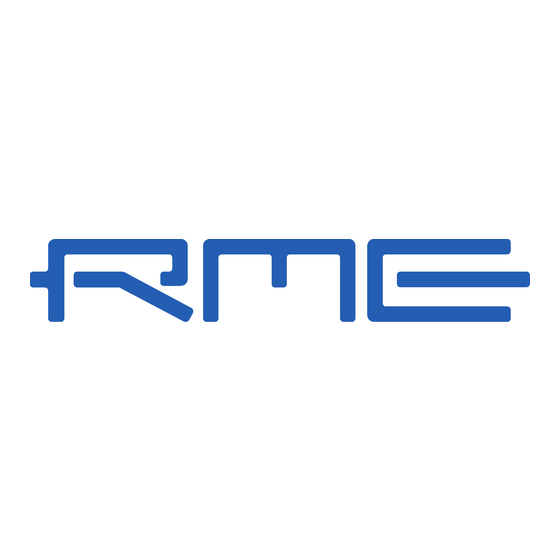Summary of Contents for RME Audio DIGI32 PRO
- Page 1 User's Guide ® ü ü 24 Bit / 96 kHz PCI-Bus Digital In/Out Card 16 / 20 / 24 Bit Digital Audio 20 Bit Analog Monitor Distributed by...
-
Page 2: Table Of Contents
Plug & Play technology. The support of up to 24 bit audio resolution and up to 96 kHz sample rate puts DIGI32 PRO at the top of the range of ™... -
Page 3: Supplied Contents
2. Supplied Contents Please ensure that all the following parts are included in DIGI32 PRO’s packaging box: • PCI Card DIGI32 PRO • Short Info • RME Driver CD • Adapter cable (XLR/cinch) • Internal cable (2 wire) 3. System requirements •... -
Page 4: Technical Specifications
Important: Switch off the computer and remove the power cable from the power supply before fitting the DIGI32 PRO. Inserting and removing the card when the computer is in operation will more than likely lead to irreparable damage to the mainboard! 1. -
Page 5: Software Installation
'ASIO Drivers' folder of the corresponding ASIO software. It is not possible to use the DIGI32 PRO with the control panel 'Monitors and Sound'! This is a restriction of the operating system. That's why Apple still ships the old control panel 'So- und', available in the Apple Extras Folder. -
Page 6: Operation And Usage
8. Operation and Usage 8.1 Connections The DIGI32 PRO has 3 external and 1 internal input and output (contact pins on the board). The internal input serves as a connection with an internal CD-ROM drive when this is supplied with a digital audio output. Advantage: the built in CD-ROM drive is sufficiant for digital recording and the need for external cabling does not arise. -
Page 7: Record
8.3 Record After the DIGI32 PRO has been set up as recording device in the software being used at the time, there are a few further points to note. Because the operating system cannot define errors exactly, it may well be that you receive the same error message for very different types of problems. -
Page 8: Record While Play
Normally the output of the card is switched off. Often it is helpful to monitor the input signal or pass it on. For such cases the DIGI32 PRO is fitted with a monitor function, which can be set in the Settings dialog of the DIGI32 PRO driver (Output/Automatic). Activating the re- cording software using Pause or Play leads to passing the input signal direct to the output. -
Page 9: Configurating The Digi32 Pro
(see chapter 10.2). In specific cases, like a direct connection of the inputs and outputs of a DAT with the DIGI32 PRO, AutoSync leads to a local feedback of the digital carrier. In such cases AutoSync can be deactivated to avoid this local loop problem. -
Page 10: Windows 95
™ 9.4 MacOS Use the Sound control panel, Sound Out, to activate DIGI32 PRO as playback device, and set up the desired sample frequency for playback. The Soundmanager will activate a software sample rate converter when the sample rate set up in Sound Out does not meet the one of the played back file. -
Page 11: Synchronisation
In most cases 'local loop-back' can be realized. A DAT used as A-D-A-Converter whose digital output is connected to the input of the DIGI32 PRO also leads to a loop and a loss of the digital carrier. But after deactivating 'AutoSync' such a loop requiring no clock master is possible even with other devices, because the DAT is not working in Full Duplex mode. -
Page 12: Special Features Of The Digital Output
In case the message box ‘New Hardware Component found’ does not appear, or the driver can´t be installed under NT: • Is the Error LED of the DIGI32 PRO lit when no cable is connected to the optical input? If not, the card is either defect or not sitting properly in the slot. -
Page 13: Installation Problems With Older Pc
• If you are sure that a valid signal is being sent but the LED is still red, then check the chosen input. • Check that the DIGI32 PRO is set as recording device under the software being used. • Check that the setting of the sample frequency in the software (recording properties or simi- lar) relates to the adjacent signal. -
Page 14: Soft- And Hardware Compatibility
Actual there is no program known not working correctly with the DIGI32 PRO. The digital inputs and outputs of the DIGI32 PRO are also 100% compatible to all devices known by us having a SPDIF or AES/EBU interface. -
Page 15: Warranty
DIGI32 PRO or its software. Thanx All people involved in the project DIGI32 PRO would like to say a big ‘Thank You’ to the following persons: Hermann Knödler for believing in us... - Page 16 In order for an installation of this product to maintain compliance with the limits for a Class B device, shielded cables must be used for the connection of any devices external to this product. User's Guide DIGI32 PRO © RME...






